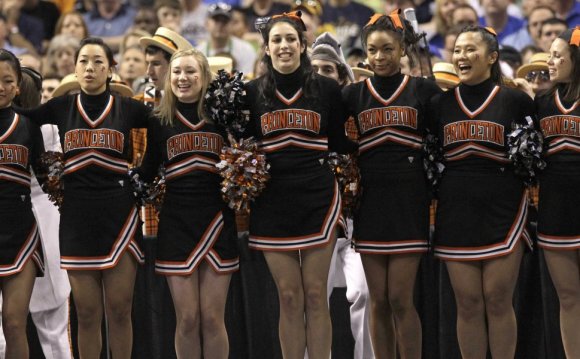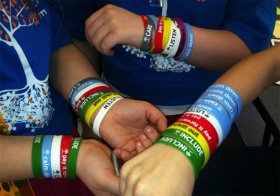

by B. Rose Huber, Woodrow Wilson School of Public and International Affairs
Curbing school bullying has been a focal point for educators, administrators, policymakers and parents, but the answer may not lie within rules set by adults, according to new research led by Princeton University researchers. Instead, the solution might actually be to have the students themselves, particularly those most connected to their peers, promote conflict resolution in school.
A team of researchers from Princeton, Rutgers University and Yale University engaged groups of influential students in 56 New Jersey middle schools to spread messages about the dangers of bullying and school conflict. Using messaging platforms such as Instagram, print posters and colorful wristbands, the selected students were encouraged to discuss in their own voices positive ways to handle conflict, using terms with which their peers could identify.
The research team wanted to test whether certain students, who they label "social referents" or social influencers, have an outsized influence over school climate or the social norms and behavioral patterns in their schools. Social referents are not necessarily the most popular kids school-wide, but rather students who demonstrate influence within their smaller peer group. All activities were designed to test whether, by making their anti-conflict stance well known, these social influencers could shape their peers' behaviors and social norms.
In the course of a year, the middle schools that employed social referents saw a 30 percent reduction in student conflict reports, the researchers report in the Proceedings of the National Academy of Sciences (PNAS). Critically, the greatest drop in conflict was observed among the teams with the highest proportion of social influencers, supporting the researchers' hypothesis that these students do exert an outsized influence over school climate.
"We designed our own curriculum because current programs address problems as defined by adults, and they aren't necessarily fitted to each individual school environment, " said lead author Elizabeth Levy Paluck, associate professor of psychology and public affairs at Princeton's Woodrow Wilson School of Public and International Affairs. "We think the best way to change social norms is to have these student influencers speak in their own voices. Encouraging their own messages to bubble up from the bottom using a grassroots approach can be very powerful."
 Peers influencing peers is a widely accepted concept. But the question of whether certain, more influential peers have more influence on social norms governing a group is what spurred Paluck and her colleagues to design their test program, the Roots program.
Peers influencing peers is a widely accepted concept. But the question of whether certain, more influential peers have more influence on social norms governing a group is what spurred Paluck and her colleagues to design their test program, the Roots program.
This program is designed to engage the school's most influential students, only some of whom fit the typical profile of a student leader or a popular student, to spread anti-conflict messages. Using a survey measurement known as social network mapping, the researchers are able to identify students with the most connections to other students, both in person and online. These students serve as the "roots" to influence perceptions and social norms in schools.
"The real innovation here is using student social networks to choose the peers ... which can lead to a less unorthodox group of student leaders, " Paluck said. "When adults choose student leaders, they typically pick the 'good' kids. But the leaders we find through social network mapping are influential among students and are not all the ones who would be selected by adults. Some of the students we find are right smack in the center of student conflicts. But the point is, these are the students whose behavior gets noticed more."
During the 2012-13 school year, Paluck and study co-authors Hana Shepherd from Rutgers University and Peter Aronow from Yale University were able to implement the study into middle schools across New Jersey. The timing was paramount. Just a year prior, Governor Chris Christie signed a bill issuing a law that required all teachers to have anti-bullying training. The bill was passed without funding.
This gave Paluck, Shepherd and Aronow a chance to offer their program as a training solution. With encouragement from the State Department of Education, they implemented the program in volunteer middle schools, as they were seeing higher rates of student conflict than high schools.
For the purposes of the experiment, half of the middle schools were randomly assigned to receive the intervention, which was training through the Roots program. The schools not selected were given the opportunity to receive free training on how to run the program at the end of the school year.
To pinpoint the most influential students, the researchers distributed a survey to the 24, 191 students enrolled at all schools. The survey asked them to nominate the top 10 students at their school who they chose to spend time with, either in or outside of school, or face to face or online. Using these data, the researchers then mapped each school's social networks.
A representative sample of 22 to 30 students in the intervention schools was invited to participate in the Roots program. Only the researchers knew which students within each group were expected to be the top influencers, based on the fact that they were in the top 10 percent of students at their school nominated by their peers in the survey.
YOU MIGHT ALSO LIKE












